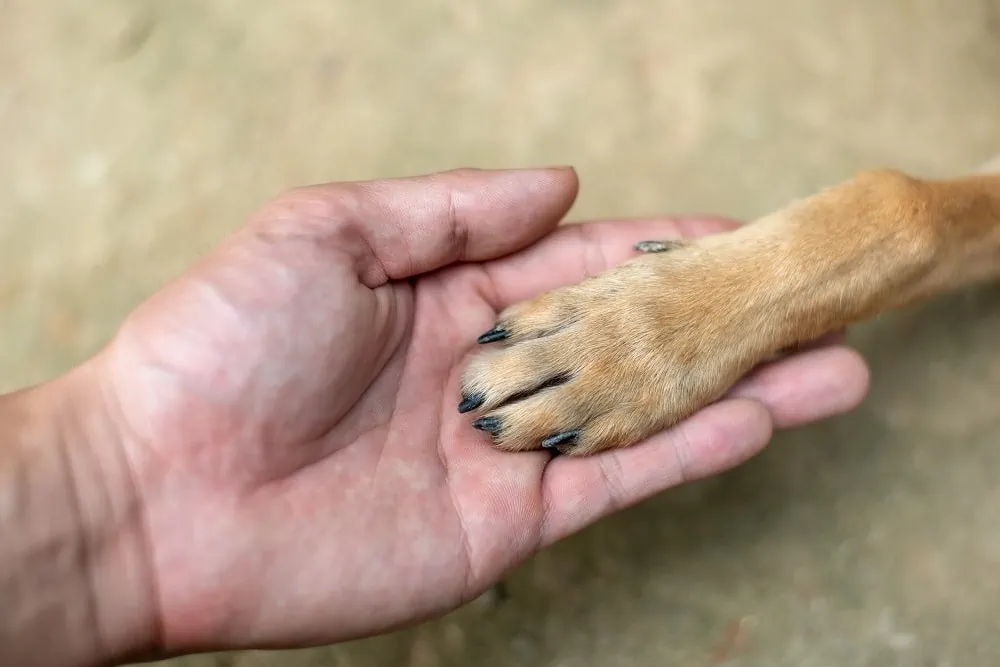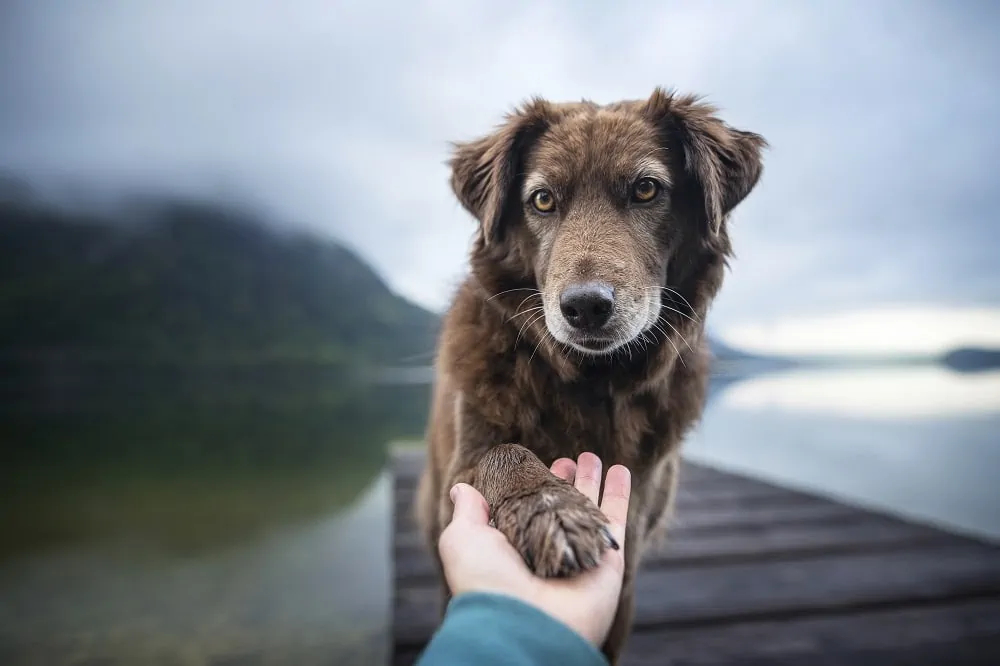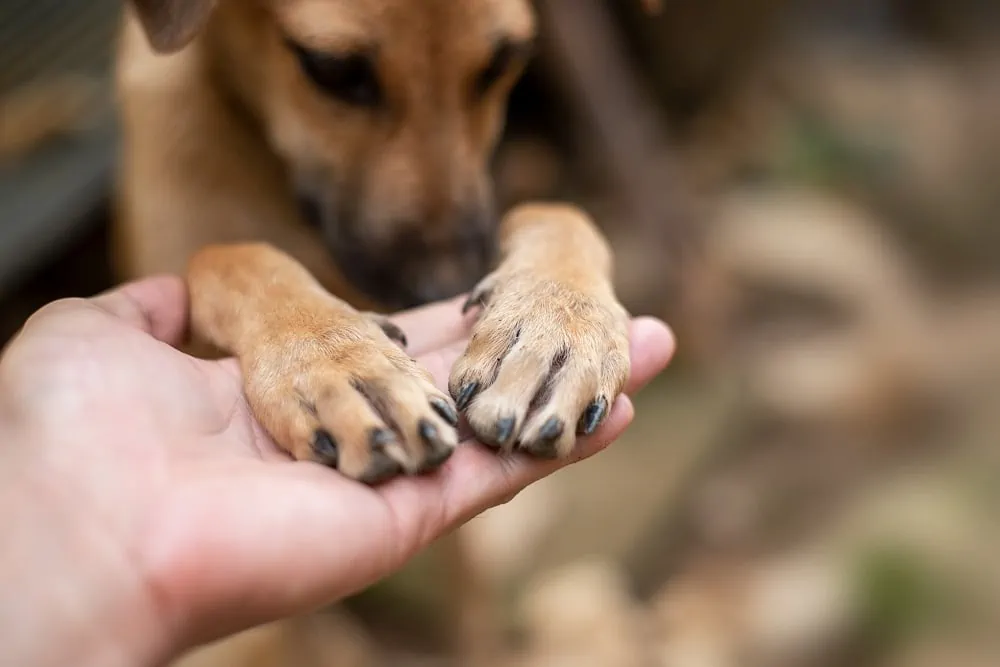The idea that your dog is talking to you – let alone that you might listen and understand – may seem utterly ludicrous.
Dogs don’t talk! Well, they can’t conjugate irregular verbs, but dogs do use a complex combination of physical and vocal cues that more or less amounts to language.
How do dogs ask for help? Dogs ask for help through a combination of signals, including body language, vocalizations (such as barking or whining) and eye contact. Dogs are effective communicators and with some effort, you’ll learn how to read your dog’s signals. If you have a good relationship with your dog, he will ask you for help and trust you to provide it.
This ‘language’ may seem impossibly mysterious, but putting in some time and effort will make you fluent. And a speaking dog is more important than you think. It strengthens the bond between you and your pup and helps you pick up health or other issues early.
Understanding Your Dog
Speaking your dog’s language is essential to creating a healthy relationship with him. Dogs are intelligent social animals that rely on communication to build and maintain bonds.
This communication isn’t limited to other dogs: because human beings have actively bred dogs over tens of thousands of years as a hunting and domestic companions, our modern canines are hardwired to bond and communicate with us (source).
Learning to speak dog isn’t difficult, but it does require you to spend time observing and interacting with your pup, and understanding his individual personality.
Don’t worry, no one is asking you to read your dog’s mind: he will use plenty of signals to tell you what he wants. With a little attention, you’ll soon be able to distinguish between an aggressive growl and one that means “let’s play.”
The rewards for understanding your dog and ‘speaking’ back to him are huge. He will know that he can ask you for help and get it, which cements trust. But you’ll also have a lot more fun together.
After all, bonding with a loving creature is one of the primary reasons for having a dog!
How Can I Understand What My Dog is Trying to Tell Me?
If your dog is in pain, he can’t verbalize this the way you can tell your friend or doctor that something is wrong. Likewise, he can’t say ‘I love you’ in so many words. But negative or positive, the worst thing you can do is ignore what your dog is trying to ‘say’.
If your dog is asking you for help, it’s often in connection with a basic need that you can relate to, which means there’s probably something simple you can do in response.
Many problems can be solved with common sense, so once you understand what your dog is trying to tell you, provide solutions where you can.
Basic Dog Communication Cues
The first step to understanding your dog is to learn the basics of dog communication: what different kinds of gesture or body language mean, and what might be causing them.
Next, be responsive to your pooch, and open to finding out what is going on with him. Always read signals in context, using what you know about your dog’s personality in conjunction with an interpretation of the situation.
Eye contact
Eye contact is a vital first step in building communication with your dog. Just like humans do, dogs use eye contact to read our emotions and intentions, as well as to indicate theirs.
There’s no great secret to tapping into this: simply look at your dog the way you would look at another person (source).
Body language
Body language is as central to canine communication as it is to human communication – despite our lack of a tail to wag. But, by watching what your dog is doing with his tail, eyes, ears, mouth, and head, you’ll quickly get a sense of his mood and desires.
Always read any particular body part in the context of his overall body position (tense? relaxed?) and energy level (bouncy? lethargic?).
Different breeds may have different versions of the common cues: some dogs’ tails naturally curl over their backs and won’t tuck between their legs. Learn what your dog’s neutral tail position is and assess how it changes in different situations (source).
Bear in mind too that artificial alterations to appearance change the signals a dog can give. If your dog’s ears have been cropped, or his tail docked, he can’t communicate properly with those body parts (source).
Vocalizations
Vocalizations are probably the first thing that comes to mind when you think about dog communication.
Dogs range from almost silent to positively chatty depending on breed and personality. Some even sing! Most vocalizations have different meanings according to the context (source).
- A high-pitched bark may be playful, while a deeper, louder bark might indicate a warning.
- Whining may indicate fear or pain; alternatively excitement or a request for attention.
- Growling usually shows aggression although some dogs growl in play. Look for other signs like raised hackles or a snarl.
- Howling is not universal in dogs, but it can be territorial, a response to sirens or a sign of loneliness.
- Purring is not reserved for cats! It’s not common in dogs but usually shows contentment.
Physical gestures
Physical gestures are perhaps the easiest communication to understand. If your dog constantly drops a ball in your lap while you sit on the couch, he probably wants to play.
If he’s scratching at the front door, he may want to go outside for a potty break. Licking your hand is a clear sign of affection.
Dogs can also use physical gestures to indicate negative feelings: avoiding contact or maintaining a distance may mean a dog is afraid of you or doesn’t want to be petted.
Six Ways Your Dog Might be Asking for Help

Sometimes understanding what your dog is trying to tell you is of immediate importance.
If he is injured, ill or afraid, it’s essential for you to read the signs and take appropriate action for the sake of his physical and mental health.
Pain
Pain can be caused by injury (such as a sprained paw), musculoskeletal issues (like hip dysplasia or arthritis), internal complications (such as pancreatitis), or infection (including periodontal disease or an ear infection).
Signs
Your dog may limp or whine when he puts weight on a particular paw or when you touch him. Less obvious signals include reluctance to walk or run, lethargy, or refusal to eat.
Be aware that if you try to touch him where he’s sore, your dog may not be able to control his response and may snap at you, so approach with caution (source).
What to do
If your dog will allow you, try to narrow down where the pain is. It may be as simple as a cut on his paw pad.
If the injury seems severe or you’re unable to find the source of the pain, seek veterinary advice as soon as possible. Never administer pain medication yourself – many human medications are toxic to dogs (source).
Nausea or illness
Possible causes of illness include food poisoning, infection of the gut from bad food, or a parasite like a heartworm. Some diseases such as parvovirus also bring these symptoms (source).
Signs
Vomiting, diarrhea, and coughing are obvious symptoms. Lethargy, loss of appetite and bloody or runny stool may also indicate illness.
What to do
If the symptoms don’t disappear within a few hours, seek veterinary advice. Vaccinating your dog regularly according to recommendations, deworming and providing tick and flea protection can avert many common diseases and parasites.
Fear
Fear is usually provoked by sudden loud noises (think Guy Fawkes fireworks) or other perceived threats (such as an unknown person). Some dogs may develop more generalized and extreme anxiety.
Signs
Your dog’s tail is tucked between the legs and his ears are laid flat back against his head. He may shiver and cower low to the ground.
His eyes may be wide and darting from side to side, avoiding eye contact, and he may pant and lick his lips (source).
What to do
Approach slowly, speaking in a low, reassuring voice. Don’t force eye contact, and try to make your body language less assertive. If your dog is in a state of extreme fear, exercise caution in approaching him, as he may lash out if he feels trapped.
Separation anxiety
Dogs, especially high-energy breeds, need plenty of emotional, physical and intellectual stimulation.
Separation anxiety is the most common anxiety in pet dogs (source), especially those accustomed to being around people, but suddenly left alone for long periods of time.
Signs
‘Troublesome’ behaviors like barking, howling, digging and chewing can be signs that your dog is lonely and anxious when separated from you.
What to do
It may not be practical to spend more time with him, so consider getting a second dog or signing your pup up for doggy daycare.
Read up on handling separation anxiety, for example by increasing exercise, providing interesting toys, gradually acclimating your dog to absence, and making less fuss when you leave (source).
Hunger
Any dog owner is familiar with the persuasive powers of a far-from-starving pooch! While it’s important not to fall for those begging eyes, it’s also vital to ensure your pooch is getting enough to eat.
Signs
A fixed stare at you and the food in your hand; whining or pawing at you. Frequently checking and licking his food bowl, staring fixedly at it or attempting to herd you towards his bowl.
What to do
If you know your dog is receiving ample food, don’t encourage begging by feeding him from the table or your plate. But if he’s skinny and seems hungry even after being fed, check that you’re feeding him enough.
The back of his kibble bag will help you calculate his requirements according to his age, weight, and breed; many websites do the same.
Aggression
It’s important to recognize signs of aggression in your dog to avoid negative consequences like a dog bite.
Signs
Your dog may display fixed eye contact and stiff body language. His ears may be erect and pointed forward, and his tail may be wagging slowly (not to be confused with the free wag he shows when he’s feeling playful).
Many dogs raise their hackles, the thick coarse hair between their shoulders. In extreme cases, your dog may snarl, growl or snap.
What to do
Immediately de-escalate the situation by removing the trigger (for example, he may have been annoyed by a child who hasn’t realized he wants to be left alone).
Try to understand what caused the aggression and look for patterns in his behavior to address the causes. Consider seeking professional help (source).
You can also try to teach your dog how to speak, see this short video here:
Communication Will Be Positive Too

The examples above are extreme cases of negative signals that your dog may be trying to send you. But there are plenty of positive things he wants to tell you too!
In fact, this is the fun part of your communication, where you can share your mutual enjoyment of activities and know that your dog is happy and healthy.
Positive emotions your dog may be trying to share with you include happiness, love, and affection, playfulness, enjoyment of activities, excitement and a desire for your attention.
Study your dog’s happy body language as closely as you study his negative cues. Signs that he’s communicating something positive include a relaxed tail wag; a play bow (your dog lowers his fore-quarters while raising his rear and wagging his tail); pricked ears; alert eyes; a wide-open mouth and lolling tongue; and a cocked head.
He may also bark or growl playfully (but be sure you know the difference and you’re confident he’s playing). He may roll over to have his belly rubbed, bring you toys to play with, or snuggle up for a cuddle.
Of course, if your dog is telling you he’s happy or excited, you should respond with enthusiasm and encouragement.
Take a few minutes to give him some affection or play a game of fetch. Encouraging your dog to communicate his positive emotions will strengthen your bond.
Recommended Post: Dutch dog commands, teach them what they need to learn.
Communication is Key and it Goes Both Ways
There is plenty of research out there about the finer points of dog body language, but if you start with the understanding that your dog’s emotions and needs are legitimate and as real as yours, you’ll be on the road to successful communication already (source).
Try to take a multi-dimensional view when it comes to reading your dog’s signals. Don’t go on a whine alone, but try to interpret the context, alongside your dog’s body language, and what you know about his ‘normal’ behavior.
Final Thoughts
Remember that your dog is also extremely sensitive to your emotions and behaviors: in fact, your dog is probably better at reading your body language than you are at reading his!
Communication goes both ways: use this knowledge to ‘speak’ effectively and positively with your pooch, and both of you will benefit for years to come.


0 Comments